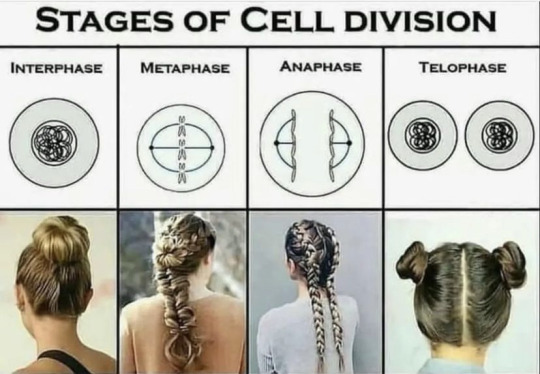#cellbiology
Text

#biology#medicalschool#biotech#science#health#biologyisawesome#biologyisfun#education#celldivision#mitosis#biologystudent#cellbiology#biology facts#lifesciences#stem#biotechnology#college prep#chemistry#maths#math#motivation
1K notes
·
View notes
Photo

Carbohydrates MCQ 25 Link in bio ☝️ for more mcqs recommendations #biotechnology #biology #science #microbiology #biotech #biochemistry #molecularbiology #research #genetics #scientist #dna #medicine #laboratory #biotechnologist #cellbiology #lab #microbiologist #medical #chemistry #biotechnologystudent #biologystudent #bio #biologymemes #lifescience #neet #bioinformatics #covid #zoology #microscope #bacteria (at Royal City Nanded) https://www.instagram.com/p/Cp4AbWivdeN/?igshid=NGJjMDIxMWI=
#biotechnology#biology#science#microbiology#biotech#biochemistry#molecularbiology#research#genetics#scientist#dna#medicine#laboratory#biotechnologist#cellbiology#lab#microbiologist#medical#chemistry#biotechnologystudent#biologystudent#bio#biologymemes#lifescience#neet#bioinformatics#covid#zoology#microscope#bacteria
3 notes
·
View notes
Photo

It's my life 🙂🧑🔬 .. Follow & explore the amazing science world🔬👇 @sdsbiology for exploring the amazing world of biology and science 😍😍❤️#sdsbiology ♡ ㅤ ❍ㅤ ⎙ㅤ ⌲ ˡᶦᵏᵉ ᶜᵒᵐᵐᵉⁿᵗ ˢᵃᵛᵉ ˢʰᵃʳᵉ 🅻🅸🅺🅴 , 🆂🅷🅰🆁🅴 🅰🅽🅳 🅲🅾🅼🅼🅴🅽🆃 .. #medical #biology #cellbiology #college #immunology #genetics #ecology #virus #bacteria #science #microbiology #biotechnology #biotech #zoology #neet #bacteriology #bacteriologia #hormones #viruses #virology #school #mbbs #instagram #ınstagood #neet #cbse #aiims #glucose #neet . https://www.instagram.com/p/CpnSbl4J1Dh/?igshid=NGJjMDIxMWI=
#sdsbiology#medical#biology#cellbiology#college#immunology#genetics#ecology#virus#bacteria#science#microbiology#biotechnology#biotech#zoology#neet#bacteriology#bacteriologia#hormones#viruses#virology#school#mbbs#instagram#ınstagood#cbse#aiims#glucose
2 notes
·
View notes
Text

Cell lines can change over time due to genetic changes. These changes can include mutations or chromosomal abnormalities that affect the way cells respond to stimuli.
Have you ever encountered unexpected results in your research that may have been due to genetic changes in your cells?
Share your experiences in the comments below!
3 notes
·
View notes
Text

#biotechnology#biology#science#microbiology#biotech#biochemistry#molecularbiology#research#genetics#scientist#dna#medicine#laboratory#biotechnologist#cellbiology#lab#microbiologist#medical#chemistry#biotechnologystudent#biologystudent#bio#biologymemes#lifescience#neet#bioinformatics#covid#zoology#microscope#bacteria
2 notes
·
View notes
Text
From Cells to Discoveries: Harnessing the Power of Primary Cell Culture

Primary cell culture stands as a cornerstone in biomedical research, offering scientists a powerful tool to explore the intricacies of cellular behavior and physiology. By isolating cells directly from living organisms and culturing them in vitro, researchers can study fundamental biological processes, investigate disease mechanisms, and develop novel therapeutic interventions. The versatility and relevance of primary cell culture have made it indispensable in advancing our understanding of human health and disease.
At its core, Primary Cell Culture involves the isolation and propagation of cells derived directly from living tissues or organs. Unlike immortalized cell lines, which have undergone genetic modifications to achieve indefinite proliferation, primary cells retain their physiological characteristics and genetic makeup. This makes them a valuable model system for studying normal cellular functions, as well as disease processes, in a more biologically relevant context.
The applications of Primary Cell Culture are vast and varied, spanning multiple fields of biomedical research. In cancer biology, primary cell culture allows researchers to study the behavior of tumor cells derived from patient samples, providing insights into tumor growth, metastasis, and drug response. Similarly, in regenerative medicine, primary cell culture serves as a platform for exploring the potential of stem cells and tissue engineering strategies to repair and regenerate damaged tissues.
Get More Insights On This Topic: Primary Cell Culture
Explore More Related Topic: Primary Cell Culture
#PrimaryCellCulture#CellBiology#ResearchTechniques#LaboratoryMethods#BiomedicalResearch#TissueCulture#CellIsolation#CellularAnalysis
0 notes
Text
Vibrio Bacteriology Question And Answers
#molecularbiology#microbiologia#genetics#cellbiology#pharmacology#scientist#anatomy#Vibrio Bacteriology Question And Answers
0 notes
Text
Cell ID Locator Technology: A Breakthrough in Urban Navigation or a Gimmick?

In the ever-evolving landscape of urban navigation, technology continues to push boundaries, and one such innovation making waves is the Cell ID Locator. Promising to revolutionize how we navigate through cities, this technology taps into the vast network of cellular towers to provide pinpoint location accuracy. But is it a genuine breakthrough or just another gimmick? In this article, we delve into the intricacies of Cell ID Locator technology to determine its true potential and impact.
Understanding Cell ID Locator Technology:
Cell ID Locator technology utilizes the unique identifier assigned to each cellular tower, commonly known as the Cell ID. Every cell tower has a distinct ID, allowing mobile devices to connect to the network seamlessly. This technology leverages these IDs to triangulate a user's location based on the signals received from nearby towers. Unlike traditional GPS, Cell ID Locator does not rely on satellite signals, making it potentially more reliable in urban environments with skyscrapers and dense infrastructure.
Breakthrough in Urban Navigation:
One of the most significant advantages of Cell ID Locator technology is its potential to address the limitations of traditional GPS systems in urban areas. Tall buildings and narrow streets often obstruct satellite signals, leading to inaccurate location data and frustrating navigation experiences. Cell ID Locator promises to overcome these challenges by tapping into the widespread cellular infrastructure, offering more reliable and precise location information even in densely populated urban environments.
This breakthrough is particularly valuable for pedestrian navigation, where GPS inaccuracies can result in missed turns and confusion. Cell ID Locator technology aims to enhance the accuracy of location-based services, providing a seamless and frustration-free urban navigation experience for users.
Real-world Applications:
The potential applications of Cell ID Locator technology extend beyond personal navigation. Emergency services, for instance, could benefit from more accurate location data in urban search and rescue operations. Delivery services and ride-sharing platforms could optimize their operations by ensuring precise pick-up and drop-off points. Furthermore, urban planners could leverage this technology for data-driven decision-making, understanding the flow of people through cities and improving infrastructure accordingly.
Gimmick or Game-Changer?
Despite its promises, the Cell ID Locator technology is not without its skeptics. Some argue that its effectiveness may be limited in rural or remote areas where cellular coverage is sparse. Additionally, concerns about privacy and data security have been raised, as the technology relies on accessing cellular tower information, potentially leading to misuse or tracking without user consent.
The accuracy of Cell ID Locator technology is also under scrutiny, as urban environments can still present challenges, such as signal interference and tower congestion. Critics argue that the technology needs further refinement to truly live up to its potential and replace traditional GPS systems effectively.
Conclusion:
In conclusion, Cell ID Locator technology represents a promising leap forward in urban navigation, addressing the limitations of traditional GPS systems in dense cityscapes. While its potential applications are vast and could revolutionize various industries, the technology is not without its challenges and skeptics. As it continues to evolve, addressing issues related to accuracy, privacy, and rural coverage will be crucial for determining whether Cell ID Locator becomes a true game-changer or remains a gimmick in the world of navigation technology. Only time will tell if this breakthrough lives up to its promises and reshapes the way we navigate our urban jungles.
#cells#science#biology#art#fluidart#microscopy#cellbiology#cell#microscope#abstractart#acrylicpouring#research#microbiology#acrylicpainting#medicine#sciart#abstract#health#painting#fluidpainting#dna#acrylic#fluidartwork#nucleus#artist#acrylicpour#cytoplasm#biotechnology#scienceart#medical
0 notes
Text
#biotechnology#biology#science#microbiology#biotech#biochemistry#molecularbiology#research#genetics#scientist#dna#medicine#laboratory#biotechnologist#cellbiology#lab#microbiologist#medical#chemistry#biotechnologystudent#biologystudent#bio#biologymemes#lifescience#neet#bioinformatics#covid#zoology#microscope#bacteria
0 notes
Text




🎯 How to Get the Heights of Success For Your Net Life Sciences Exam? 🎯
📚 Part A of CSIR NET Life Science Golden Units 📚
✅ Understand the Syllabus:
✅ Study Material:
✅ Create a Study Plan:
✅ Practice Previous Year Papers:
✅ Mock Tests:
✅ Analyze Your Performance:
✅ Learn Time Management:
✅ Stay Updated with Current Affairs:
✅ Form Study Groups:
✅ Revision is Key:
✅ Stay Confident:
✅ Seek Guidance:
⏳ Join Online Class > https://www.gyanbinduonline.com/
📲 +91 935 017 2220
#csirnet#lifescience#ugcnet#biochemistry#microbiology#biotechnology#csirnetlifesciences#genetics#cellbiology#lifesciences#zoology#bestcoaching#iitjam#molecularbiology#education#organicchemistry#le arning#biologystudent#cellularbiology
0 notes
Text

Researchers are using a variety of techniques to study cancer, including:
Genetics: Cancer is a genetic disease, and researchers are studying the genes that are involved in cancer development.
Cell biology: Researchers are studying how cancer cells grow and divide.
Immunology: Researchers are studying how the immune system can be used to fight cancer.
Chemistry: Researchers are developing new drugs to treat cancer.
Visit: https://symbiosisonlinepublishing.com/cancerscience-research/
#cancer#cancerscience#cancerresearch#research#researchers#immunology#genetics#chemistry#cellbiology#symbiosisonlinepublishing
0 notes
Text

These are the stages of cell division
#biology#biotech#medicalschool#health#science#biology is cool#biology is fun#biologystudent#biomed#cellbiology#microbiology#nanobiology#chemistry#meiosis#mitosis#cell division
19 notes
·
View notes
Photo

Protein MCQ 46 Link in bio ☝️ for more mcqs recommendations #biotechnology #biology #science #microbiology #biotech #biochemistry #molecularbiology #research #genetics #scientist #dna #medicine #laboratory #biotechnologist #cellbiology #lab #microbiologist #medical #chemistry #biotechnologystudent #biologystudent #bio #biologymemes #lifescience #neet #bioinformatics #covid #zoology #microscope #bacteria (at Royal City Nanded) https://www.instagram.com/p/Cp9r2uFPedi/?igshid=NGJjMDIxMWI=
#biotechnology#biology#science#microbiology#biotech#biochemistry#molecularbiology#research#genetics#scientist#dna#medicine#laboratory#biotechnologist#cellbiology#lab#microbiologist#medical#chemistry#biotechnologystudent#biologystudent#bio#biologymemes#lifescience#neet#bioinformatics#covid#zoology#microscope#bacteria
3 notes
·
View notes
Text

Volvox
#microbiology#biology#science#biotechnology#biochemistry#microbiologist#laboratory#lab#molecularbiology#microscope#bacteria#biotech#genetics#cellbiology#research#microscopy#biologystudent#scientist#dna#microbiologylab#digitalart#art#drawing#illustration#artist#artwork#digitaldrawing#digitalillustration#fanart#artistsontumblr
0 notes
Text

Are you looking for Hela cell line for your in vitro studies?
Kosheeka is here to provide you with the best-quality cell lines.
📃 Order Now
📲 Call/Whatsapp +91-9654321400
🌐 https://kosheeka.com/product/cells-lines-hela/
#cellculture#cellbiology#celllinedevelopment#biochemistry#research#biotechnology#laboratoryprofessionals
3 notes
·
View notes